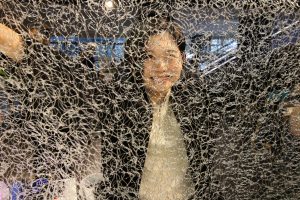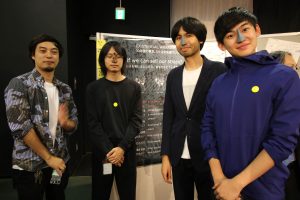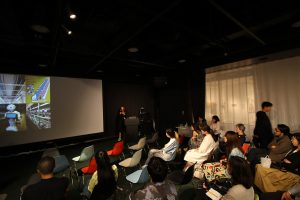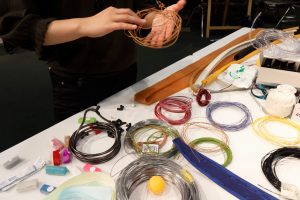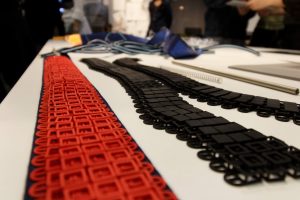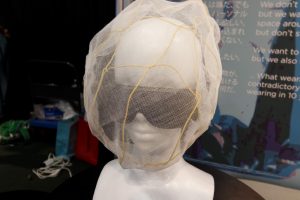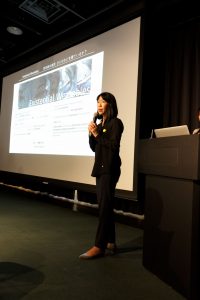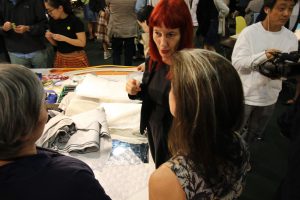A report/Narrativisation from UX Designer of the Existential Wearables Event
(29 Sept, 2018 @ Shibuya Hikarie)
“What people are going to wear in Tokyo in ten years” is an stimulating question.
We are trying to put into real designs the ideas and dialogues about people who we have not met and a new age no one has even seen.
It is difficult to predict the future in our age. The economics world called it “VUCA” age. Originally a military jargon, “VUCA” takes the caption letters from”Volatility”, “Uncertainty”, “Complexity”, and “Ambiguity”.
In this kind of complexity and diversity, “dialogue” attracts our attention. Dialogues lead to new discoveries, new ideas, and understanding/meaning of one’s self and relation with the wider society. This process is called “emergence”.
Mental model of this process to create meanings can be roughly divided into the following three:
1) Mental model to create human beings (religion, philosophy, ethics and morality)
2) Mental model to convey authority and history (legends, folklores)
3) Mental model in the field of learning, guiding, and counseling.
There are differences in these models among the individuals and collective groups. Complete sharing of mental model is difficult. Through hearing and sharing, however, similar mental models take shapes. The elements to lead to this kind of sharing and sense of sympathy include “reality”, “believability”, “feasibility”, “relatable”, “attention”, “attraction”. This process diverges from “embedded narrative” and is called “emergent narrative”. It is exactly this mechanism that bridges sense of sympathy with others with new ideas.
UX Design also constructs dialogues with its pre-assumed users and customers. Through systems of software designs and engineering, dialogues will be facilitated and barriers of operation will be lessen. It wishes to build more convenient tools and better relationship that meet the needs of the future.
Gen Tatsumi, UX Designer
PIVOT Inc.
https://pivot.jp/
UXデザイナーのナラティブ化
2018年9月29日 実存ウェアラブルプロジェクト 第1フェーズフィナーレ@渋谷ヒカリエによせて
「10年後の東京、ヒトは何を着ているか」とても刺激的な問いかけである。
10年後の東京とは、どのような人が住み、どのような環境、社会を形成しているのだろうか?「Existential Wearable」実存的ウェアラブル、まだ存在はしないが未来には存在しうる着衣物とは、一体どんなものなのか?
見たことのない時代、あったことのない人々が使うモノを考えて作り、その過程、結果から生まれる対話と共感を元に、モノを具現化していく。
現代社会は、将来予測が困難な時代であり、世界経済界ではVUCA時代の到来と言われている。VUCAとは、もともと軍事用語で、Volatility(変動性)、Uncertainty(不確実性)、Complexity(複雑性)、Ambiguity(曖昧性)の頭文字からなる。産業と科学による人口の増加、それに伴う自然環境の変化と経済影響、2000年以降の世界経済の急速なグローバル化、IT技術の進歩に伴う、あらゆる市場で既存ビジネスモデルの崩壊と再構築、情報通信量の増大に伴う、さまざまなニーズの変化に対応した市場の細分化。めまぐるしい変化の中で共通の価値軸が失われ、不確実性が増加している。
価値の創造と創出の手段としてUXデザイン(ユーザー体験のためのデザイン)や、デザイン思考といった価値創造の仕組みを考える職種が求められる理由も、時代を反映していると言える。
しかし体験と、その結果としての価値は主観的なもので、そのものを作り出すのは難しい。現代社会の潮流も、多様性による環境の複雑さが原因となっているのだろう。
従来の論理的思考に基づいた議論では、新たな解決策が生まれない問題も、正解の主張では収束ができないほどに複雑になっているからだと思われる。
そこで注目されるのが対話(Dialogue)である。
対話を重ねることで個々人が持つ認知の単純な総和ではなく、新しい角度から物事を見ることによる発見と、このパラダイムシフトによる、全く新しい発想が生まれることがある。この現象を創発(Emergence)という。
対話は問題の原因を特定することが目的ではなく、当事者の一人として新たな解決策を創発する。対話は自己の内面の語りであり、他者の内面の受け入れでもある。つまりコミュニケーションによる共感によって新たなアイデアを創発するといえよう。
アイデアが、さまざまな問題を解決し、継続的に社会を動かす原動力となるものであり、なにかを強引に推し進めるのではなく、人々の心が変化し、行動する文化と習慣を作るものであるならば、共感力が強いアイデアが、良いアイデアであるといってもおかしくはないだろう。
自己を語るとき、人は自己の持つ認識の枠組みや知識を使って世界を理解し自分なりの意味を生成する。これは個人の見方による世界と自分の姿であり、その人の存在する文化の枠組み(言語、歴史、象徴など)に影響され、また自身も言語を使用し社会への働きかけ(表現)をすることで社会に影響を与える。この意味と意味を作るプロセスをメンタルモデルといい大きく3つに分けられる。
・人間らしさを形成するメンタルモデル(宗教、哲学、倫理や道徳)
・権威や歴史を伝えるためのメンタルモデル(伝説、伝承、昔話)
・学習、誘導、カウンセリングにおけるメンタルモデル(教育、医療)
これらのメンタルモデルは、年長者からの教育、コミュニケーション、自己の体験、情報からの学習といった手法のいくつかと異なる順序によって取得される。これらの過程には、学習と体験の差(量や質)、関係するコミュニティによる差(集合知や常識)、身体的能力(性別、視力や聴力など)、生存した時期(時代背景、環境)から、個体差や個別集団差が生じる。
そのため完全な情報の共有というのは難しい。しかし人の体験談をメンタルモデルとして聞くことで、近いメンタルモデルが自身に形成される。これは、語りの内容(要素)が、自身が体験したこととオーバーラップまたは、あたかも体験したかのように感じることがあるはずである。この共感を誘発する要素として、Reality(追体験の誘発)、Believability(没入感の構築)、Feasibility(臨場感の構築)、Relatable(世界観の構築)、Attention(存在感の構築)、Attraction(物語の構成)があり、これらの要素を強く感じることで、語りは強化され、他者との強い共感が生まれる。これはEmbedded Narative(あらかじめ用意された物語)から、Emergent Narrative(創発される物語)が作られる工程であり、このメカニズムが機能しなければ、他者との共感から新しいアイデアは生まれないのだろう。
ソフトウエアエンジニアリングにおけるUXデザインの工程にも、ユーザーインタビューやテストといった対話の手法がある。想定ユーザーや顧客をペルソナとし、彼らに提供できる価値までの物語を感情の変化や生活の様式を想像した上で構築する。
しかし、この工程において、我々デザイナーは人を客体化してしまうため、物語にビジネスのバイアスがかかってしまいがちである。同時にいつも心の中にわだかまりとして、このペルソナ、客体化された架空の人物は誰なのだろうかという疑問が残っていた。
ペルソナとして想定された現実の人と対話しているとき、彼らが語る物語は、デザイナーの想定した物語との答え合せになっているのではないかという疑問があった。
しかし、このプロジェクトに参加し、アドバイザーという立場ながら、多くの学びを得ることができた。デザイナーである僕も、ナラティブなデザインにおいては当事者であり、自分の内面、知見を語ることで、ユーザーと解決策を創発していく、Embedded NarativeからEmergent Narrativeへのプロセスと仕組みの設計に取り組むという新しい課題も生まれた。
ソフトウエアデザインとエンジニアリングによって作られるシステムは、技術進歩によって、操作を必要としない、もしくは対話による稼働へと進化している。デザイナーがモノを通じて、利用者とより深い対話をしていく時代になりつつある。これからの時代に必要な、物語による対話と知見の融合によって創発される価値を多くの人が学び、便利な道具を作り、よい関係性を築いて行けることを願う。
立見 元 UXデザイナー
Microsoftで、Microsoft OfficeのUIデザイナーとして7年の修行を経て、株式会社OPTiMのデザイン部門の創設、IoTとAIプラットフォームとサービス群の開発、会社ブランディングなどを担当し、2018年から株式会社PIVOT R&D部門のUXデザイナーとして、「ちょっと世の中を便利にするしくみ」を研究している。
株式会社PIVOT
株式会社PIVOTは、企画、Webサイト構築~運営支援、アプリ開発、システム開発まで、UIを中心にしたモノづくりでユーザー体験を追求しているデザイン会社です。
使いやすさや見た目の美しさだけで無く、「心を動かす体験」をユーザーに提供するために、表には出ない裏側の仕組みや構造も含めたトータルの設計を手掛けています。
https://pivot.jp/
